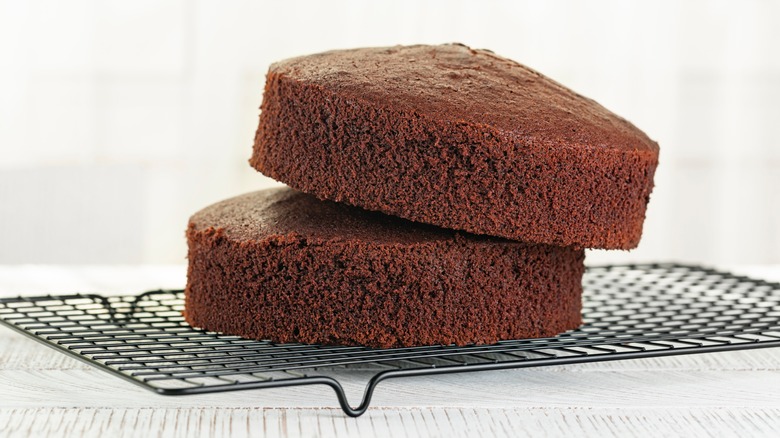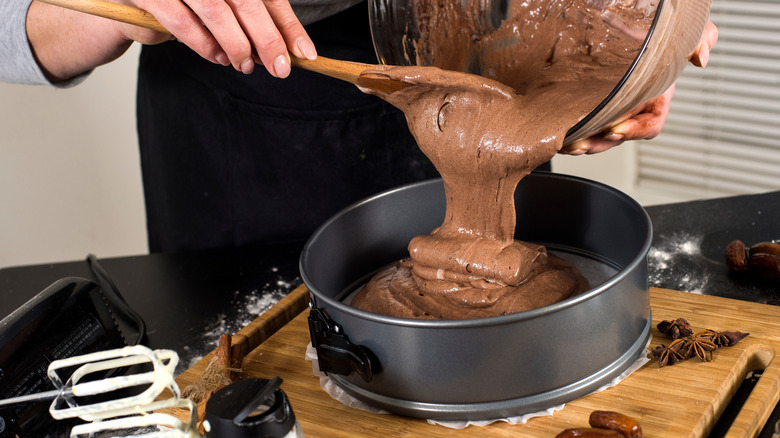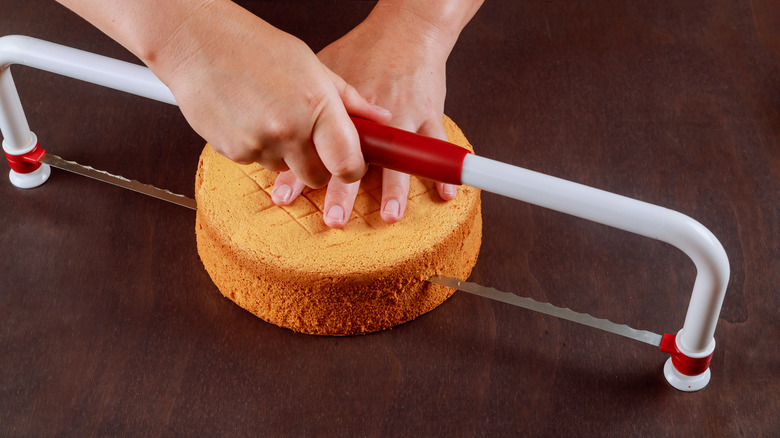The Baking Mistake That Causes Domed Cakes
Most fluffy cake recipes come out of the oven with a raised, rounded top. This isn't a problem if you serve the cake as-is with a simple icing or glaze on top, but excessive doming can spell disaster for layered and/or decorated cakes. Every layer in a multi-tier cake needs to be perfectly flat, or they'll tip off-balance and slide off of each other, and a dome is also not the most stable surface for piped icing decorations, candles, fruits, and other toppings.
How does a perfectly level layer of cake batter become so bulbous? It usually boils down to the cake pan or oven temperature. A pan that is too small for the batter inside can cause the middle of the cake to rise up. The batter at the edges of the pan sets and expands as it bakes, forcing the surplus of batter in the middle of the pan to rise. This excess batter has nowhere to go but up, creating a dome.
Another mistake you might make while baking is setting your oven too high. Even if you set your oven to the temperature in the recipe, your cake pan might heat too quickly, resulting in an uneven baking job. Next thing you know, you've got a cake that's overcooked around the edges and undercooked (and highly domed) in the middle. Luckily, a few precautions can mitigate these unfortunate effects.
How to avoid making domed cakes
An obvious precaution against doming is to always use a correctly-sized cake pan. Some bakers will tell you that you can use smaller pans than are called for in a cake recipe, so long as you adjust the bake time. This might be fine overall, but puts you at risk for a highly domed cake, as well as cracks on the surface. Yes, you can (and probably should) cut off the very tops of cake layers to get rid of the doming, but cracks can go further down into the cake, making the interior dry and decorating much harder.
As for preventing doming in a too-hot oven, you can try setting your oven lower by about 10 degrees Fahrenheit. Using this method, your cake can bake more evenly, but you'll need to adjust your bake time for a lower, slower cook. Alternatively (or in conjunction with the lower temp), you can use cake strips, which are cloth bands that you soak in water and wrap around a cake pan to lower and even out its temperature. If you don't have any strips, use our damp towel trick for a similar effect.
You can also wrap the inside of your pan with a double layer of tin foil to insulate your batter from the heat of the oven. All of these methods help your cake bake at a steadier pace, resulting in an even cook all the way through. Are you feeling like a pro yet?
Can you fix a cake that has already domed?
If you wind up with some mountain-like cakes, despite your best efforts, a domed dessert isn't the end of the world. The simplest fix is to wait until the cake has cooled, and then use a large serrated knife to cut the excess off the top. If you're a serious baker, you can buy a cake leveler, which is basically a piece of wire or a blade strung between the ends of an adjustable frame. These allow you to cut your cake layers to an exact thickness, which can create more stable and pretty-looking treats.
Regardless of how you level your cake, be sure to place the cut side facing down when it's time to frost it, so you have a smooth top to work with instead of exposed crumb. You don't want to have to hide messy frosting dotted with loose cake bits.
Of course, you can also accept your cake for what it is. Try frosting it in green to make it look like a grassy hill, and dot the surface with edible flowers. If you use a solid and stable frosting like buttercream, which doesn't slip around or slump when piped into designs, decorating a domed cake can be easier. Using an outer layer of frosting as "glue" and pressing candies, fruits, and sprinkles into the surface can also prevent toppings from rolling off of domed cakes.



